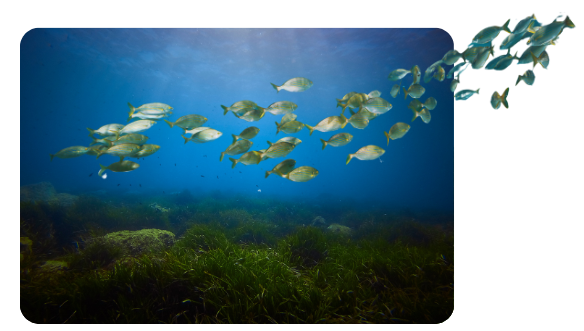Story
Offshore wind farms: new paper reveals global impacts on biodiversity and ecosystem services
30 January 2024
To help meet net-zero emission targets by 2050, it is estimated that there will need to be a drastic increase in the development of offshore windfarms across the world. As such, PML scientists have led a paper that, for the first time, takes a holistic approach to investigating the global impacts of offshore wind farms on biodiversity and ecosystem services – to support decision making during this time of rapid expansion, for the best outcomes for both people and the planet.

Socio-ecological impacts are of growing importance in the planning and assessment of offshore wind farms globally, however, to date, few studies have investigated the impacts of them on the human dimensions of environment, and especially the goods and benefits they receive from them.
Offshore wind farm development has become a key measure of the global energy transition in recent years. To meet net-zero emission targets, many countries around the world are planning considerable expansions in offshore wind farms.
It is estimated that 2000 Gigawatts (GW) of offshore wind farms will need to be installed worldwide by 2050 – a drastic increase from the mere 35 GW installed back in 2020. This would require around 5000 new turbines installed every year, occupying more than 500,000 km2 of ocean by 2050.
What is a Gigawatt?
A Gigawatt is equal to one billion watts. To put that into perspective, one Gigawatt is equivalent to 2.4 Million Photovoltaic (PV) Panels, 310 Utility-Scale Wind Turbines, or 100 Million LED Bulbs.
[Source: Office of Energy Efficiency and Renewable Energy]
However, these areas of the ocean are also hotspots of biodiversity, provide attractive landscapes and are under strong anthropogenic pressures. Preserving and restoring the natural and cultural resources of coastal and offshore territories while intensifying renewable marine energies, represents one of the most important challenges for future management of marine environments. Consequently, systematic reviews that consider all the effects of offshore wind farms on ecosystems and society are essential.
In particular, understanding the net positive or negative impacts of offshore wind farms on ecosystems, biodiversity, and also ecosystem services (such as commercial fishing), can serve as a framework for the implementation of management actions to identify cumulative ecological impacts and trade-offs between ecosystem services.
As such, a new study led by our Dr Stephen Watson, has taken a holistic approach to consider the global consequences of the construction and operation phases of offshore wind farms.
Access the publication: “The global impact of offshore wind farms on ecosystem services’ >>
Dr Watson commented on the study findings, published last week on Science Direct:
“Results have shown that during the construction phase of offshore wind farms, impacts were predominantly negative across the ecological subject groups (52%), compared with positive impacts (8%). And we saw that several species of fish (such as brill, cod, dab, plaice) and some species of birds (including common guillemot, northern fulmar, redhead) showing strongly negative trends.”

Above: A Guillemot – the common name for several species of seabird in the Alcidae or auk family. Guillemots typically only come to land to nest, spending the rest of their lives at sea.
“Operational phase impacts were more variable and could be either negative (32%) or positive (34%) depending on site specific conditions. More detailed investigations into fish, shellfish, humans and air-surface studies recorded a net positive effect of wind farm operations on these subject groups.”
“Once operational, some studies have found that the foundations of offshore wind structures act as artificial reefs and attract biodiversity, providing space for the settlement, shelter and foraging for some animals (including pelagic and demersal fish, marine mammals, juvenile corals and other benthic sessile invertebrates). Likewise, by restricting activities that can negatively affect the environment, offshore wind farms can act as an de facto marine-protected areas (MPA), which can potentially enhance both biodiversity and commercial fisheries in surrounding areas.”

Above: The undersea foundations of “Eureka’ – an oil rig nearing the end of its life in Southern California. Installed in 1984, it has been operational for decades and has grown a thriving ecosystem of marine life comparable to natural coral reef systems. This is known as the “artificial reef effect’. Find out more about Eureka and its biodiversity here: https://www.nationalgeographic.com/environment/article/oil-rig-eureka-reef-marine-wildlife
“The most substantially enhanced ecosystem services included effects on commercial fisheries and experiential recreation. Social acceptance toward new and hypothetical offshore wind farms was also strongly positive, irrespective of country location. Negative effects on ecosystem services, including existence values for culturally important groups, e.g., marine mammals and birds and the spread of non-native species – such as invasive barnacles, jellyfish, Pacific Oyster, slipper limpet, or Japanese skeleton shrimp -are potentially of most significance.”

Above: A Japanese skeleton shrimp, an invasive species.
“Unfortunately, we have discovered that more than 86% of possible offshore wind farm impacts on ecosystem services are still unknown – and we desperately need this data to be able to be able to support decision-makers in making decisions during this time of rapid expansion.”
Access the publication: “The global impact of offshore wind farms on ecosystem services’ >>
There was a large number of contributing authors from Plymouth Marine Laboratory including: Stephen C. L. Watson, Paul Somerfield, Andrew Edwards-Jones, Joana Nunes, Christine Pascoe, Caroline Louise McNeill, Claire Szostek and Nicola Beaumont.
Additional authors of the publication include Anaëlle J. Lemasson and Antony M. Knights from the University of Plymouth, Heather Baxter from Plymouth Marine Laboratory and the UK Energy Research Centre, and Michaela Schratzberger, Murray S.A. Thompson and Elena Couce from the Centre for Environment, Fisheries and Aquaculture Science (CEFAS).
Related information
This research was undertaken as part of the UK Energy Research Centre research programme. Funded by the UK Research and Innovation Energy Programme under grant number EP/S029575/1 and the DREAMS project (Decommissioning – Relative Effects of Alternative Management Strategies, INSITE 2 programme [https://www.insitenorthsea.org]), Grant reference: NE/T010843/1.
